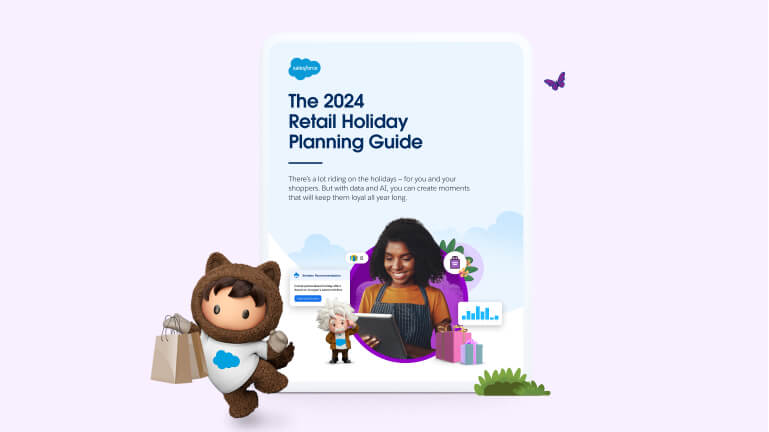Good customer service is the key to winning shoppers’ hearts. It’s so important, 47% of shoppers said they were willing to pay extra for better customer service.
Whether it’s helping them compare products, finding an item in-store, or sorting out an ecommerce return over the phone, retail customer service is as important to building your company’s brand as marketing. To put it into perspective, the quality of a brand’s customer service influences 71% of customers’ purchase decisions.
But what do we mean by “customer service”? Like everything else about retail, it continues to evolve alongside customer expectations.
Let’s look at:
- What is retail customer service?
- Why is retail customer service so important during the holiday season?
- What are the biggest challenges in retail customer service?
- How can you evolve retail customer service?
- What does a great retail customer service experience look like?
- 4 ways to improve retail customer service
What is retail customer service?
Retail customer service now involves any activity that helps shoppers get what they need. Consumers consider services like free shipping, loyalty rewards, simple returns, extensive product variety, and exclusive shopping events all part of how a retailer serves their needs.
That’s why retailers are transforming customer service agents into trusted advisors both online and in person. Research shows that 88% of customers say good service makes them more likely to purchase again.
Build Your Best Holiday Shopping Season Strategy
Why is retail customer service so important during the holiday season?
Exceptional customer service is especially important during the holiday season. With the added stresses of time pressures, crowded stores, budget constraints, and the race to find the perfect gift, excellent customer service goes a long way in helping your shoppers feel supported when they need it most. Because shoppers are especially busy and short on time (and patience) during the holiday shopping season, a poor customer service interaction can seem especially irritating, turning the shopper into a Grinch with a long memory. Bad service experiences could mean they never buy from you again.
(Back to top.)
What are the biggest challenges in retail customer service?
As the number of shopper touchpoints continues to grow, so does the level of complexity when it comes to meeting customer needs. With 71% of shoppers preferring to use multiple channels when they buy, traditional customer service has expanded to include both in-store and online, with transactions often starting at one and ending with the other.
To reduce friction for shoppers, provide a seamless and connected customer service experience across every point of engagement. This can mean:
- Helping shoppers order a product currently out of stock for pickup at a different store or delivery to their home
- Assisting a customer via live chat to find a store where they can make an exchange
- Curbside delivery or other easy ways to fulfill buy online, pickup in store orders.
When surveyed, 74% of customers said they expect to be able to do anything online they can do in person or by phone. In today’s retail environment, you need to meet shoppers wherever they are and offer them personalized customer service tailored to their needs and expectations.
(Back to top.)
How can you evolve retail customer service?
As technology evolves, so do the ways shoppers interact with retail customer service workers. Tools such as artificial intelligence-powered chatbots help agents quickly sort assistance requests and automate tasks that don’t require human decision-making. This helps your team scale customer service offerings so they can quickly resolve customer issues without requiring additional personnel during the busy holiday season.
Online returns can also be automated using artificial intelligence (AI) to recommend return options, including replacement product suggestions. For customers, providing a humanized experience that feels easy and natural to the shopper is the key to implementing AI within your customer service offerings.
(Back to top.)
What does a great retail customer service experience look like?
The best brands make customers feel their questions have been answered and their needs understood. No matter if it’s returning a product, tracking an order, or asking for recommendations, consumers will walk away from an interaction with peace of mind. And when the occasional mistake occurs, 75% of shoppers say you can redeem yourself and reinforce their trust by responding with excellent customer service.
This means being proactive and transparent by providing answers to questions before the shopper even asks them.
(Back to top.)
4 ways to improve retail customer service
Help deliver frictionless shopping experiences that create loyal shoppers with these strategies:
1. Give service agents a complete view of customer data
With so many channels for communication, service agents need access to the right data at every point of the customer journey. Although 70% of customers expect all company representatives to have access to the same information about them, 55% say it feels like they’re speaking with separate departments rather than one company. This can leave shoppers feeling frustrated while increasing the time it takes to resolve issues.
By having the right data available to all customer service agents using a centralized cloud platform that updates in real time, agents avoid asking customers for the same information over and over. Instead, they can pick up wherever the customer left off without asking them to explain themselves, so issues are quickly resolved to everyone’s satisfaction.
(Back to top.)
2. Use generative AI for faster, personalized service
From generating custom email messages quickly to interacting with customers directly via chatbot, AI is set to revolutionize how customers engage with you. In fact, customer experience has been the main focus for 50% of retailers’ early generative AI strategies.
AI can help speed up time-consuming tasks for customer service agents, like finding the right solution in a knowledge base and generating personalized messaging, which 31% of retailers feel is the most practical use of AI right now. In 2024, 24% of retailers are already using AI to create summaries of customer service cases to help other agents faced with similar requests quickly search for and find the right solution to known issues.
This allows your customer service agents to provide speedier outcomes and more personalized service while responding to multiple customers. As AI technology continues to evolve, you’ll want to strategically use it to humanize interactions and make customers feel both understood and connected to your brand.
(Back to top.)
3. Make finding answers easier with self-service
We all need a helping hand from time to time. But if an issue is simple, it’s often easier and faster to handle it yourself. Provide your customers with the self-service tools to take care of simple issues on their own. For example, 29% of retailers are harnessing AI to create conversational, digital shopping assistants to help shoppers find the right product or service or for simple tasks. These include printing a return shipping label, renewing a subscription, or changing a payment method. Self-service options free up live agents to work on more complex problems.
And guess what? A 61% majority of retail customers prefer using a self-service solution to resolve minor issues. Your customer service team will be in a better position to handle the most challenging requests, which is especially important during busier shopping periods like Black Friday and Cyber Week.
(Back to top.)
4. Use the communications channels customers prefer
Because customers vary in how they ask for help, it’s important you offer seamless customer service wherever they engage. For example, 93% of them prefer email, 72% opt to chat online, and 64% choose social media to engage with brands.
And don’t forget about the phone. Although customers prefer self-service tools for simple issues, 81% of service agents say customers prefer the phone for complex problems. Urgent issues and complicated situations often require a conversation with a rep so they can explain the situation clearly. And when customers do contact you with an issue they can’t resolve themselves, don’t leave them hanging: 77% expect to interact with a human immediately.
A real conversation allows customers to explain nuances of their situation, so your service team can walk them through possible solutions and provide reassurance if they feel confused or overwhelmed.
(Back to top.)
Turn retail customer service into your greatest asset
A finely-tuned customer service department can be a powerful branding tool. In fact, 75% of customers will recommend a company based on excellent customer service. It’s the lynchpin that connects shopping with a level of brand trust that drives repeat customers. With these tactics, you’ll create a level of service that keeps customers coming back throughout the year.
(Back to top.)
Give the gift of great service for the holidays.
Get ready for holiday shopping season by amping up everything from marketing to commerce, operations to (of course) service. It’s all in The 2024 Retail Holiday Planning Guide.

































